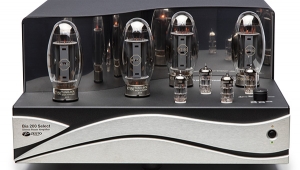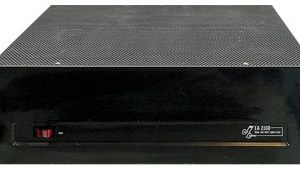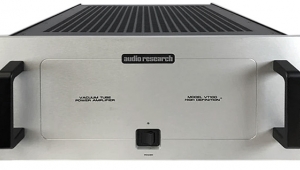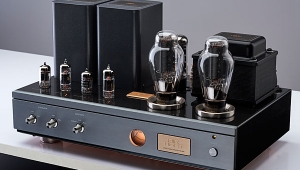| Columns Retired Columns & Blogs |
Wavac SH-833 monoblock power amplifier Page 2
Accidents
Despite having been carefully packed in substantial wooden crates, the SH-833 arrived damaged, including a bent isolation-transformer chassis, which is constructed not from sheet metal but from solid metal plates that range in thickness from 10mm to 50mm. There was more damage in one of the main amplifiers. It took the designer the better part of a day to undo the pallet punter's work. (I didn't get special treatment: a visit from a Wavac rep., most likely Yuzuro Ito or Yasunori Matsuki, is part of what your $350,000 buys you.) A week or so into the review, one channel failed, and back the designer came. Turned out to be a cracked power resistor—probably a result of shipping trauma.
Despite having been carefully packed in substantial wooden crates, the SH-833 arrived damaged, including a bent isolation-transformer chassis, which is constructed not from sheet metal but from solid metal plates that range in thickness from 10mm to 50mm. There was more damage in one of the main amplifiers. It took the designer the better part of a day to undo the pallet punter's work. (I didn't get special treatment: a visit from a Wavac rep., most likely Yuzuro Ito or Yasunori Matsuki, is part of what your $350,000 buys you.) A week or so into the review, one channel failed, and back the designer came. Turned out to be a cracked power resistor—probably a result of shipping trauma.
Let's stick together
In the bridge of the Mamas and the Papas' "California Dreamin' " there's a flute solo that, if you've heard it once, you've heard it a thousand times. Me, I've heard it a million times. Yet when I heard that flute through the SH-833s during one of my many "I wonder what that record sounds like through these amps..." sessions, I was taken by complete surprise. I literally sat up, taking notice of that flute as never before.

What had always been a thin and familiar-sounding, dismissible shadow of a disconnected flute floating just above the music bed suddenly became a compelling performance by an actual human being standing there blowing air through his lips. The SH-833s reproduced the sound of the flute with more of the tonal, textural, spatial, and presentational cues heard when you hear a flutist performing live.
That's what the SH-833 did with every instrument or voice it reproduced. It made everything seem more alive, more real, more pure. Was it the truth, or a euphonic coloration? If it truly sounded more alive, more convincing of reality, does it matter? Do you really think that hard, brittle-sounding amplifiers that measure "perfectly" are giving you "the truth"? I can't answer that question.
I haven't spent all that much time listening to SET amplifiers—the original Cary Audio Design CAD-805 monoblocks of about a decade ago were about it. They were enjoyable, but my kind of listening requires more of a foundation, greater solidity, and far more slam. But I've heard no amplifiers like the Wavac SH-833s. The listening experience was so fundamentally different from anything else I've heard that I'm still not quite sure what to make of it. As one audiophile friend remarked after listening to a few tunes, "I've never heard anything like that before." He meant that it sounded more like real music.
Can it be that everything else is wrong and the Wavacs are right? Or that the Wavacs are fundamentally wrong but fundamentally more fun? Can an amplifier that made the Wilson Audio WATT/Puppy 7 loudspeakers sound entirely different from how they'd ever sounded before possibly be close to linear? As you read this, you can glance at JA's "Measurements" Sidebar to find the answer—but as I write this, he hasn't yet measured the Wavacs, so I don't know. Nor am I sure that measurements can reveal how the SH-833 reacts to the particular load the WATT/Puppy 7 presents. (I used the 4 ohm tap.)
What I can tell you is that the SH-833 did what I'd expect of a superbly executed SET amplifier: it had absolute midrange purity, physicality, transparency, and especially delicacy. These are easily the most musically sensual, delicate, wrap-your-musical-heart-around-them, physically and emotionally palpable amplifiers I have ever heard. Getting this level of delicacy, transparency, solidity, and speed in one package is what's new for me—especially the speed of resolution.
Though it sounds like a contradiction in terms, the SH-833 sounded rich and warm and had tremendous powers of resolution. It managed to balance these qualities in a way that resulted in an unusually and spectacularly seamless and coherent performance. It was also remarkably quiet. Music erupted from the kind of jet-black silence usually associated with solid-state gear—but with far more grace, delicacy, liquidity, and transparency. Sound never seemed to be coming from, or sticking to, the loudspeakers.
After sitting through a "top loader" UK pressing of The Beatles ("The White Album")—one of the first records I played through the Wavacs—I was left in awe. Objectively speaking, the bottom end was fuller than I'm used to and the top was somewhat on the mellow side, though not to the point of sounding muted or dull. It was as if the highest frequencies on this somewhat brash recording, which usually sounds ragged and somewhat aggressive, had been perfectly polished rather than lopped off. Everything that was supposed to be there was there, while everything you'd want removed was gone.
The naturalness of the midrange on this recording was essentially flawless, and far more convincing, detailed (via resolution as opposed to peakiness), coherent, and physically present than I'd ever heard it. Paul McCartney's voice appeared between the speakers with a timbral and textural reality that was a new experience for me. The sense of him being "there" as living flesh was never so pronounced.
The string section in George Harrison's "Piggies" asserted itself with the surprising importance of that flute in "California Dreamin'"—with a warm, woody weight and textural believability that heretofore had escaped notice in my 35 years of listening to it. If the harpsichord lost a bit of transient edge, it was more than made up for by the physicality of each note being struck. The SH-833s had something new to say about just about every recording I played through them.
While it's true that a certain level of brightness I've come to expect from the WATT/Puppy 7s and from certain discs was suspiciously missing in action, somehow, the high-frequency harmonic structures and transient details remained sufficiently in play to satisfy. Unlike some other warmish-sounding amplifiers I've auditioned, the SH-833s didn't guide me toward playing midrange-heavy acoustic music that would show off the their strengths while not calling attention to their deficiencies.
- Log in or register to post comments



































